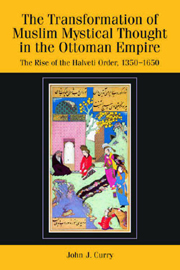 The Transformation of Muslim Mystical Thought in the Ottoman Empire
The Transformation of Muslim Mystical Thought in the Ottoman Empire Book contents
- Frontmatter
- Contents
- List of Maps and Figures
- Abbreviations for Frequently Cited Works in the Text
- Acknowledgments
- Note on Transliteration
- Map 1
- Map 2
- INTRODUCTION: ON THE STUDY OF OTTOMAN MYSTICAL TRADITIONS
- PART I THE RISE AND SPREAD OF THE HALVETİ ORDER FROM ITS ORIGINS THROUGH THE ELEVENTH/SEVENTEENTH CENTURY
- PART II THE EVOLUTION OF A HALVETİ SUB-BRANCH: THE LIFE AND CAREER OF ŞAcBÂN-I VELİ AND HIS FOLLOWERS IN THE KASTAMONU REGION
- PART III DEFENDING THE CULT OF SAINTS IN ELEVENTH/SEVENTEENTH-CENTURY KASTAMONU: TRANSFORMING THE ŞAcBÂNİYE ORDER UNDER cÖMER EL-FUɔÂDÎ
- INTRODUCTION
- 6 cÖMER EL-FUɔÂDÎ AS SUFI ASPIRANT AND HAGIOGRAPHER: THE ROAD TO ŞAcBÂNİYE SUCCESSION
- 7 INSCRIBING THE ŞAcBÂNİYE ORDER ONTO KASTAMONU'S LANDSCAPE
- 8 THE POLITICAL AND DOCTRINAL LEGACY OF cÖMER EL-FUɔÂDÎ
- CONCLUSION: WHAT CAN THE ŞAcBÂNİYE TEACH US ABOUT TRANSITIONS IN THE EARLY MODERN PERIOD OF WORLD HISTORY?
- Appendix I
- Appendix II
- Works Cited and Further Reading
- Index of Persons
- Index of Places
- Index of Subjects
7 - INSCRIBING THE ŞAcBÂNİYE ORDER ONTO KASTAMONU'S LANDSCAPE
from PART III - DEFENDING THE CULT OF SAINTS IN ELEVENTH/SEVENTEENTH-CENTURY KASTAMONU: TRANSFORMING THE ŞAcBÂNİYE ORDER UNDER cÖMER EL-FUɔÂDÎ
Published online by Cambridge University Press: 12 September 2012
- Frontmatter
- Contents
- List of Maps and Figures
- Abbreviations for Frequently Cited Works in the Text
- Acknowledgments
- Note on Transliteration
- Map 1
- Map 2
- INTRODUCTION: ON THE STUDY OF OTTOMAN MYSTICAL TRADITIONS
- PART I THE RISE AND SPREAD OF THE HALVETİ ORDER FROM ITS ORIGINS THROUGH THE ELEVENTH/SEVENTEENTH CENTURY
- PART II THE EVOLUTION OF A HALVETİ SUB-BRANCH: THE LIFE AND CAREER OF ŞAcBÂN-I VELİ AND HIS FOLLOWERS IN THE KASTAMONU REGION
- PART III DEFENDING THE CULT OF SAINTS IN ELEVENTH/SEVENTEENTH-CENTURY KASTAMONU: TRANSFORMING THE ŞAcBÂNİYE ORDER UNDER cÖMER EL-FUɔÂDÎ
- INTRODUCTION
- 6 cÖMER EL-FUɔÂDÎ AS SUFI ASPIRANT AND HAGIOGRAPHER: THE ROAD TO ŞAcBÂNİYE SUCCESSION
- 7 INSCRIBING THE ŞAcBÂNİYE ORDER ONTO KASTAMONU'S LANDSCAPE
- 8 THE POLITICAL AND DOCTRINAL LEGACY OF cÖMER EL-FUɔÂDÎ
- CONCLUSION: WHAT CAN THE ŞAcBÂNİYE TEACH US ABOUT TRANSITIONS IN THE EARLY MODERN PERIOD OF WORLD HISTORY?
- Appendix I
- Appendix II
- Works Cited and Further Reading
- Index of Persons
- Index of Places
- Index of Subjects
Summary
The success of the Menâkιb among its audience in the Kastamonu region helped to consolidate the order at a time when a new generation of followers, increasingly distanced from its subject, were coming to the fore. In many cases, the work's appearance would represent the final point at which the historian could continue tracking the evolution of an order's narratives and doctrines under their hagiographer's direction. Yet what makes the Şacbâniye especially fruitful for historical inquiry is that we can continue tracking their evolution through the subsequent activities of its membership and the continued output of their leader, cÖmer el-Fuɔâdî. Growing acclaim for the Menâkýb soon translated into attempts to transform the burial place of Şacbân-ı Veli into a fully-fledged Sufi institution. This infrastructure building further swelled the order's following, which required more educational initiatives to better prepare them for growing challenges emerging during a religiously and politically turbulent eleventh/seventeenth century.
CONSTRUCTING A TOMB FOR ŞAcBÂN-İ VELİ AMID GROWING POLITICAL INSTABILITY
The spread of Fu'âdî's hagiography had an immediate impact that resonated far beyond the Şacbâniye. We have already seen its dedication to Sultan Ahmed I, and its arrival at court may well have sparked the enthusiasm of a Kastamonu native who had risen to a position of power there. This dignitary, cÖmer Kethüdâ (d. 1020/1611), had risen to become a steward to a powerful Ottoman grand vizier, Kuyucu Murad Paşa (d. 1020/1611).
- Type
- Chapter
- Information
- The Transformation of Muslim Mystical Thought in the Ottoman EmpireThe Rise of the Halveti Order, 1350–1650, pp. 223 - 267Publisher: Edinburgh University PressPrint publication year: 2010


